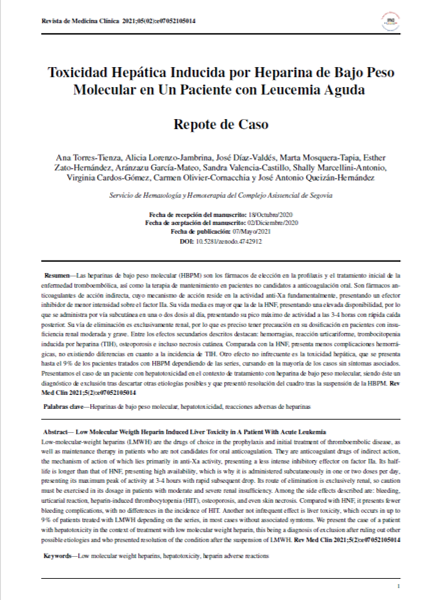Abstract
Low-molecular-weight heparins (LMWH) are the drugs of choice in the prophylaxis and initial treatment of thromboembolic disease, as well as maintenance therapy in patients who are not candidates for oral anticoagulation1,5,6. They are anticoagulant drugs of indirect action, the mechanism of action of which lies primarily in anti-Xa activity, presenting a less intense inhibitory effector on factor IIa1,2. Its half-life is longer than that of HNF, presenting high availability, which is why it is administered subcutaneously in one or two doses per day, presenting its maximum peak of activity at 3-4 hours with rapid subsequent drop. Its route of elimination is exclusively renal, so caution must be exercised in its dosage in patients with moderate and severe renal insufficiency.
Among the side effects described are: bleeding, urticarial reaction, heparin-induced thrombocytopenia (HIT), osteoporosis, and even skin necrosis2,5. Compared with HNF, it presents fewer bleeding complications, with no differences in the incidence of HIT. Another not infrequent effect is liver toxicity, which occurs in up to 9% of patients treated with LMWH depending on the series, in most cases without associated symtoms1,5.
We present the case of a patient with hepatotoxicity in the context of treatment with low molecular weight heparin, this being a diagnosis of exclusion after ruling out other possible etiologies and who presented resolution of the condition after the suspension of LMWH.
References
Carlson MK, Gleason PP, Sen S. Elevation of hepatic transaminases after enoxaparin use: Case report and review of unfractionated and low-molecular-weight heparin-induced hepatotoxicity. Pharmacotherapy. 2001;21(1):108-113. doi:10.1592/phco.21.1.108.34436.
Páramo J.A, Gónzalez-Porras J.R, Mateo J. Hemostasia y Trombosis. Manual práctico. Madrid: Arán; 2018.
Hui C, Yuen M, Ng IO, Tsang KW. Heparin-Induced Liver Toxicity. J Clin Pharmacol. 2001;41:691-694. (url:https://doi.org/10.1177/00912700122010465)
Baker EL, Loewenthal T, Salerno E, Baker WL. Probable enoxaparin-induced hepatotoxicity. Am J Heal Pharm. 2009;66(7):638-641. doi:10.2146/ajhp080311.
Zaera De La Fuente C, Arribas Anta J, López-San Román A, Cañete Ruiz Á, López Durán S. Hepatotoxicidad secundaria a enoxaparina. Gastroenterol Hepatol. 2015;38(7):438-439. doi:10.1016/j.gastrohep.2014.06.010.
Ann Pivarnik K, Schiffman F, Sullivan J, Finn A. Enoxaparin-induced hepatotoxicity: An under-recognised complication of enoxaparin therapy. BMJ Case Rep. 2016;2016:1-3. doi:10.1136/bcr-2016-216592.
Montesinos P, Sanz M.A, Barragan E, Martinez J. Recomendaciones para el tratamiento de primera línea de la leucemia mieloblástica aguda NPM1 positivo en pacientes de edad menor o igual a 65 años candidatos a quimioterapia intensiva. Protocolo LMA-NPM1-17. https://www.fundacionpethema.es. Grupo PETHEMA; 2017: 1-44.
Bratt G, Törnebohm E, Widlund L, Lockner D. Low molecular weight heparin (KABI 2165, Fragmin): pharmacokinetics after intravenous and subcutaneous administration in human volunteers. Thromb Res. 1986;42(5):613-620. doi:10.1016/0049-3848(86)90340-3.
Jacobsohn W, Oren A. Hyper-transaminasemia with Heparin Therapy. Br Med J. 1975;3(5975):77. doi:10.1136/bmj.3.5975.77.
Christiansen HM, Lassen MR, Borris LC, et al. Biologic tolerance of two different low molecular weight heparins. Semin Thromb Hemost. 1991;17(4):450-454. doi:10.1055/s-2007-1002654.
Nielsen HK, Husted SE, Koopmann HD, et al. Heparin-induced increase in serum levels of aminotranferases. A controlled clinical trial. Acta Med Scand. 1984;215(3):231-233.
Borstad E, Urdal K, Handeland G, Abildgaard U. Comparison of low molecular weight heparin vs. unfractionated heparin in gynecological surgery. Acta Obstet Gynecol Scand. 1988;67(2):99-103. doi:10.3109/00016348809004178.
Harenberg J, Giese C, Dempfle CE, Stehle G, Heene DL. Biological activity and safety of the subcutaneous administration of high doses of low molecular weight heparin for 8 days in human volunteers. Thromb Haemost. 1989;61(3):357-362. doi:10.1055/s-0038-1646595.
Dukes GE Jr, Sanders SW, Russo J Jr, et al. Transaminase elevations in patients receiving bovine or porcine heparin. Ann Intern Med. 1984;100(5):646-650. doi:10.7326/0003-4819-100-5-646.
Saffle JR, Russo J, Dukes GE, Warden GD. The effect of low-dose heparin therapy on serum platelet and transaminase levels. J Surg Res. 1980;28(4):297-305. doi:10.1016/0022-4804(80)90089-X.
Guevara A, Labarca J, González-Martin G. Heparin-induced transaminase elevations: a prospective study. Int J Clin Pharmacol Ther Toxicol. 1993;31(3):137-141.
Olsson R; Korsan Bengtsen BM; Korsan Bengtsen K; Lennartsson J; Waldenstroem J. Serum aminotransferases after low-dose heparin treatment. Short Communication. Acta Med. Scand. 1978; 204: 229-230.
Naranjo CA, Busto U, Sellers EM, et al. A method for estimating the probability of adverse drug reactions. Clin Pharmacol Ther. 1981;30(2):239-245. doi:10.1038/clpt.1981.154.
Lucena MI, García-Cortés M, Cueto R, Lopez-Duran J, Andrade RJ. Assessment of drug-induced liver injury in clinical practice [published correction appears in Fundam Clin Pharmacol. 2009 Feb;23(1):147]. Fundam Clin Pharmacol. 2008;22(2):141-158. doi:10.1111/j.1472-8206.2008.00566.x.
Morales M. L, Vélez L. N, Muñoz M. OG. Hepatotoxicity: A drug-induced cholestatic pattern. Rev Colomb Gastroenterol. 2016;31(1):36-47. doi:10.22516/25007440.71.

This work is licensed under a Creative Commons Attribution-NonCommercial-NoDerivatives 4.0 International License.
Copyright (c) 2021 Revista de Medicina Clínica

